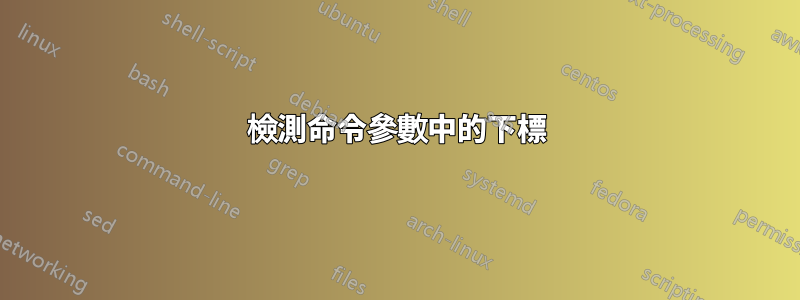
low我定義了一個向參數添加下標的命令:
\newcommand{\low}[1]{{#1}_{l_{\mathcal{A}}}}
但是,如果 的參數low本身包含下標(例如在 的情況下\low{\low{\Sigma}}),則不容易看出外部引入的下標low屬於整個參數而不僅僅是第一個下標。因此,如果 的參數low包含下標,我想自動引入括號(所以\low{\low{\Sigma}}應該看起來像\low{(\low{\Sigma})}.
為了實現這一目標,我使用 xifthen 套件嘗試了以下操作:
\newcommand{\low}[1]{\ifthenelse{\isin{_}{#1}}{{(#1)}_{l_{\mathcal{A}}}}{{#1}_{l_{\mathcal{A}}}}}
然而令我驚訝的是,這個指令有時只會插入括號。特別是在上面給出的示例中它沒有這樣做。為什麼會發生這種情況?
編輯:問題似乎是\isin沒有展開命令的定義。 @egreg 已經提供了一個答案,允許我檢查巢狀調用,\low但不適用於包含帶有下標的其他命令的參數。有人有適用於任意參數的解決方案嗎?
答案1
在某些情況下,應用\protected@edef並\@onelevel@sanitize在檢查“字串化”之前_可能會解決問題:
\documentclass{article}
\usepackage{amsmath}
\usepackage{xifthen}
\makeatletter
\DeclareRobustCommand\DetectUnderscore[1]{%
\begingroup
\protected@edef\@tempa{#1}%
\@onelevel@sanitize\@tempa
\expandafter\expandafter\expandafter\endgroup
\expandafter\expandafter\expandafter\ifthenelse
\expandafter\expandafter\expandafter{%
\expandafter\expandafter\expandafter\isin
\expandafter\expandafter\expandafter{%
\expandafter\expandafter\string_%
\expandafter}%
\expandafter{%
\@tempa}}{{(#1)}}{{#1}}%
}%
\newcommand\low[1]{%
\DetectUnderscore{#1}%
_{l_{\mathcal{A}}}%
}
\makeatother
\begin{document}
\[
\low{\Sigma} \qquad
\low{\low{\Sigma}} \qquad
\low{\low{\low{\Sigma}}} \qquad
\]
\[
\low{\Sigma_b} \qquad
\low{\low{\Sigma_b}} \qquad
\low{\low{\low{\Sigma_b}}} \qquad
\]
\[
\low{{\Sigma_b}} \qquad
\low{b_{\low{c_{\low{\Sigma_d}}}}} \qquad
(\Sigma_b)_{l_\mathcal{A}}
\]
\[
\low{\low{1} + 2}
\]
\end{document}
\expandafter導致下一個令牌(如果可擴展)在下一個令牌(如果可擴展)擴展之前恰好擴展一次。 (La)TeX 考慮\expandafter當下一個標記的擴展完成時已完成的工作。因此,您可以使用 的鏈/序列\expandafter讓 (La)TeX “跳過” k 個標記,以先擴展第 (k+1) 個標記。
\@onelevel@sanitize\macro更改 的定義\macro,以便吐出類別代碼 12(其他)的字元標記序列,該序列看起來像在應用 之前\macro「吐出」的標記序列。這幾乎就像透過應用 的定義的每個標記來重新定義您所得到的結果。\macro\@onelevel@sanitize\macro\string\macro
\protected@edef定義一個宏,但在此之前,它會擴展定義文字的所有可擴展標記,除了那些透過標記定義\DeclareRobustCommand或前面帶有標記的標記之外\protect。您可能會說:\protected@edef在實際執行分配之前,是否「展開」其定義文字中包含的標記的定義。
\@tempa是一個臨時宏,它透過\protected@edef擴展為參數來定義#1,所有定義都在#1「展開」中。
-test\ifthenelse{\isin...}並沒有發現_嵌套在大括號中,因為大括號通常具有特殊功能。因此,\@onelevel@sanitize適用於將所有標記(以及花括號)轉換為類別代碼 12(其他)的普通無害字元標記,不會幹擾測試\ifthenelse{\isin...}。
這是一個例程,它不會透過以下方式檢查類別代碼 12(其他)的(字串化)下劃線第十次's \ifthenelse{\isin...}-thingie 但會檢查類別代碼 8(下標)的標記,而無需字串化。
在檢查構成參數的標記時,例程會遞歸地呼叫自身。
這個例程仍然沒有擴展論證——這仍然必須通過 來完成\protected@edef。
\documentclass{article}
\usepackage{amsmath}
\makeatletter
%%-----------------------------------------------------------------------------
%% Paraphernalia ;-) :
%%.............................................................................
\newcommand\UD@firstoftwo[2]{#1}%
\newcommand\UD@secondoftwo[2]{#2}%
\newcommand\UD@exchange[2]{#2#1}%
\newcommand\UD@removespace{}\UD@firstoftwo{\def\UD@removespace}{} {}%
%%-----------------------------------------------------------------------------
%% Extract first inner undelimited argument:
%%.............................................................................
%% \UD@ExtractFirstArg{ABCDE} yields {A}
%%
%% \UD@ExtractFirstArg{{AB}CDE} yields {AB}
%%
%% !!! The argument of \UD@ExtractFirstArg must not be empty. !!!
%% You can check for emptiness via \UD@CheckWhetherNull before applying
%% \UD@ExtractFirstArg.
%%.............................................................................
\newcommand\UD@RemoveTillUD@SelDOm{}%
\long\def\UD@RemoveTillUD@SelDOm#1#2\UD@SelDOm{{#1}}%
\newcommand\UD@ExtractFirstArg[1]{%
\romannumeral0%
\UD@ExtractFirstArgLoop{#1\UD@SelDOm}%
}%
\newcommand\UD@ExtractFirstArgLoop[1]{%
\expandafter\UD@CheckWhetherNull\expandafter{\UD@firstoftwo{}#1}%
{ #1}%
{\expandafter\UD@ExtractFirstArgLoop\expandafter{\UD@RemoveTillUD@SelDOm#1}}%
}%
%%-----------------------------------------------------------------------------
%% Check whether argument is empty:
%%.............................................................................
%% \UD@CheckWhetherNull{<Argument which is to be checked>}%
%% {<Tokens to be delivered in case that argument
%% which is to be checked is empty>}%
%% {<Tokens to be delivered in case that argument
%% which is to be checked is not empty>}%
%% The gist of this macro comes from Robert R. Schneck's \ifempty-macro:
%% <https://groups.google.com/forum/#!original/comp.text.tex/kuOEIQIrElc/lUg37FmhA74J>
%%.............................................................................
\newcommand\UD@CheckWhetherNull[1]{%
\romannumeral0\expandafter\UD@secondoftwo\string{\expandafter
\UD@secondoftwo\expandafter{\expandafter{\string#1}\expandafter
\UD@secondoftwo\string}\expandafter\UD@firstoftwo\expandafter{\expandafter
\UD@secondoftwo\string}\expandafter\expandafter\UD@firstoftwo{ }{}%
\UD@secondoftwo}{\expandafter\expandafter\UD@firstoftwo{ }{}\UD@firstoftwo}%
}%
%%-----------------------------------------------------------------------------
%% Check whether argument's first token is a catcode-1-character
%%.............................................................................
%% \UD@CheckWhetherBrace{<Argument which is to be checked>}%
%% {<Tokens to be delivered in case that argument
%% which is to be checked has leading
%% catcode-1-token>}%
%% {<Tokens to be delivered in case that argument
%% which is to be checked has no leading
%% catcode-1-token>}%
\newcommand\UD@CheckWhetherBrace[1]{%
\romannumeral0\expandafter\UD@secondoftwo\expandafter{\expandafter{%
\string#1.}\expandafter\UD@firstoftwo\expandafter{\expandafter
\UD@secondoftwo\string}\expandafter\expandafter\UD@firstoftwo{ }{}%
\UD@firstoftwo}{\expandafter\expandafter\UD@firstoftwo{ }{}\UD@secondoftwo}%
}%
%%-----------------------------------------------------------------------------
%% Check whether brace-balanced argument starts with a space-token
%%.............................................................................
%% \UD@CheckWhetherLeadingSpace{<Argument which is to be checked>}%
%% {<Tokens to be delivered in case <argument
%% which is to be checked>'s 1st token is a
%% space-token>}%
%% {<Tokens to be delivered in case <argument
%% which is to be checked>'s 1st token is not
%% a space-token>}%
\newcommand\UD@CheckWhetherLeadingSpace[1]{%
\romannumeral0\UD@CheckWhetherNull{#1}%
{\expandafter\expandafter\UD@firstoftwo{ }{}\UD@secondoftwo}%
{\expandafter\UD@secondoftwo\string{\UD@CheckWhetherLeadingSpaceB.#1 }{}}%
}%
\newcommand\UD@CheckWhetherLeadingSpaceB{}%
\long\def\UD@CheckWhetherLeadingSpaceB#1 {%
\expandafter\UD@CheckWhetherNull\expandafter{\UD@secondoftwo#1{}}%
{\UD@exchange{\UD@firstoftwo}}{\UD@exchange{\UD@secondoftwo}}%
{\UD@exchange{ }{\expandafter\expandafter\expandafter\expandafter
\expandafter\expandafter\expandafter}\expandafter\expandafter
\expandafter}\expandafter\UD@secondoftwo\expandafter{\string}%
}%
%%.............................................................................
%% Check whether brace-balanced argument starts with a token of
%% category code 8 (subscript)
%%.............................................................................
%% \UD@CheckWhetherFirstTokenHasCatcodeSubscript{<Argument which is to be checked>}%
%% {<Tokens to be delivered in case that
%% <argument which is to be checked> has a first
%% token of catcode 8>}%
%% {<Tokens to be delivered in case that
%% <argument which is to be checked> does not have
%% a first token of catcode 8>}%
%%
\newcommand\UD@CheckWhetherFirstTokenHasCatcodeSubscript[1]{%
\romannumeral0%
\UD@CheckWhetherNull{#1}{\UD@exchange{ }{\expandafter}\UD@secondoftwo}{%
\UD@CheckWhetherBrace{#1}{\UD@exchange{ }{\expandafter}\UD@secondoftwo}{%
\UD@CheckWhetherLeadingSpace{#1}{\UD@exchange{ }{\expandafter}\UD@secondoftwo}{%
\expandafter\expandafter\expandafter\UD@@CheckWhetherFirstTokenHasCatcodeSubscript
\UD@ExtractFirstArg{#1}%
}%
}%
}%
}%
\newcommand\UD@@CheckWhetherFirstTokenHasCatcodeSubscript[1]{%
\expandafter\ifcat_#1%
\expandafter\UD@firstoftwo\else\expandafter\UD@secondoftwo\fi
{\UD@exchange{ }{\expandafter}\UD@firstoftwo}%
{\UD@exchange{ }{\expandafter}\UD@secondoftwo}%
}%
%%-----------------------------------------------------------------------------
%% Check whether argument does contain underscore/tokens of
%% category code 8 (subscript), no matter if nested in braces or not.
%%
%% \UD@CheckWhetherSubscriptTokens{<Argument which is to be checked>}%
%% {<Tokens to be delivered in case that
%% <argument which is to be checked> contains
%% some token(s) of catcode 8 (subscript)>}%
%% {<Tokens to be delivered in case that
%% <argument which is to be checked> contains
%% no token of catcode 8 (subscript)>}%
%%
%%-----------------------------------------------------------------------------
\newcommand\UD@CheckWhetherSubscriptTokens{\romannumeral0\UD@@CheckWhetherSubscriptTokens}%
\newcommand\UD@@CheckWhetherSubscriptTokens[3]{%
\UD@CheckWhetherNull{#1}{ #3}{%
\UD@CheckWhetherLeadingSpace{#1}{%
\expandafter\UD@@CheckWhetherSubscriptTokens\expandafter{\UD@removespace#1}{#2}{#3}%
}{%
\UD@CheckWhetherBrace{#1}{%
\expandafter\expandafter\expandafter\UD@CheckWhetherSubscriptTokens
\UD@ExtractFirstArg{#1}{ #2}{%
\expandafter\UD@@CheckWhetherSubscriptTokens\expandafter{\UD@firstoftwo{}#1}{#2}{#3}%
}%
}{%
\UD@CheckWhetherFirstTokenHasCatcodeSubscript{#1}{ #2}{%
\expandafter\UD@@CheckWhetherSubscriptTokens\expandafter{\UD@firstoftwo{}#1}{#2}{#3}%
}%
}%
}%
}%
}%
\DeclareRobustCommand\UD@CallUD@CheckWhetherSubscriptTokensOnExpansion[1]{%
\begingroup
\protected@edef\@tempa{#1}%
\expandafter\endgroup
\expandafter\UD@CheckWhetherSubscriptTokens\expandafter{\@tempa}{{(#1)}}{{#1}}%
}%
\newcommand\low[1]{%
\UD@CallUD@CheckWhetherSubscriptTokensOnExpansion{#1}_{l_{\mathcal{A}}}%
}
\makeatother
\begin{document}
% Let`s use | and \myunderscore in the same way as _ :
\catcode`\|=8
\let\myunderscore=_
\[
\low{\Sigma} \qquad
\low{\low{\Sigma}} \qquad
\low{\low{\low{\Sigma}}} \qquad
\]
\[
\low{\Sigma\myunderscore b} \qquad
\low{\low{\Sigma\myunderscore b}} \qquad
\low{\low{\low{\Sigma|b}}} \qquad
\]
\[
\low{{\Sigma_b}} \qquad
\low{b_{\low{c_{\low{\Sigma|d}}}}} \qquad
(\Sigma_b)_{l_\mathcal{A}}
\]
\[
\low{\low{1} + 2}
\]
\end{document}
請注意,此例程的目的不是檢測_類別代碼12(其他)的(字串化)字元標記,而是檢測類別代碼8(下標)的所有字元標記(無論是明確的還是隱式的) 。
答案2
一個想法(不是直接的解決方案)是將參數放在一個盒子內,並用您認為不太高而需要括號的字元的高度檢查其高度,但又不太短而無法在 \Sigma 中添加括號。
猜猜我們的預設參數是什麼:\Sigma... P
程式碼(包含一些測試)是這樣的:
\documentclass{article}
\def\DefLowArg{$\Sigma$}
\let\oldDefLowArg\DefLowArg
\newsavebox{\myAbox}
\newsavebox{\myBbox}
\newcommand{\low}[2][\DefLowArg]{\savebox\myAbox{\vbox{#1}}\savebox\myBbox{\vbox{\ensuremath{#2}}}
\ifdim\dimexpr\ht\myAbox+\dp\myAbox<\dimexpr\ht\myBbox+\dp\myBbox\relax
\left({#2}\right)_{l_{\mathcal{A}}}
\else {#2}_{l_{\mathcal{A}}}\fi
}
\begin{document}
\[\low{\low{\Sigma}}\]
\[\low{\Sigma}\]
\[
\low{\sum_{i=3}^5 F(x)}
\]
\[
\low{\frac{F(x)}{x+5}}
\]
\[\low{F_x}\]
\[\low[1/4]{F(x)}\]
\[\low{x^2}\]
\[
\low{G_x}
\]
These commands may be should add without parentheses
\[
\low{g(z)}
\]
\[
\low{F(x)}
\]
{\bfseries Solution 1 Add an tall optional argument in the command like: \verb|\low[/]{F(x)}|}
\[
\low[/]{g(z)}
\]
\[
\low[/]{F(x)}
\]
{\bfseries Solution 2 Change the Default argument \verb|\DefLowArg| to something tall enough (return with \verb|\let\DefLowArg\oldDefLowArg|):}
\xdef\DefLowArg{/}
\[
\low{g(z)}
\]
\[
\low{F(x)}
\]
\let\DefLowArg\oldDefLowArg
{\bfseries And back to default}
\[
\low{F(X)}
\]
\end{document}
這會產生:
PS:當然,在特殊情況下應該添加手動解決方案,但無論如何在您的命令中,我確信在許多情況下您都會有例外。




